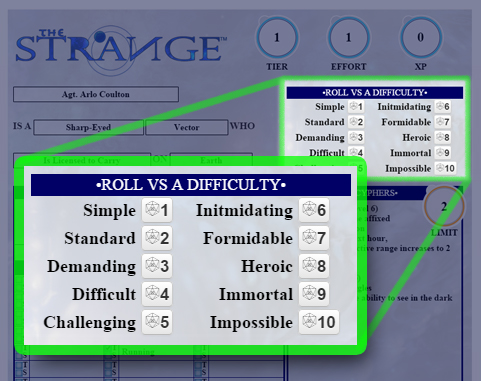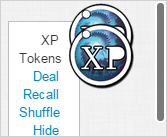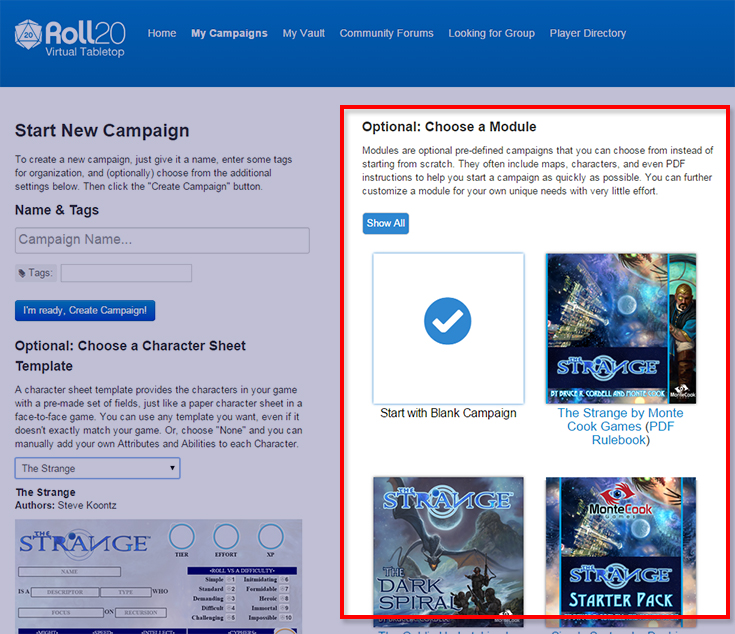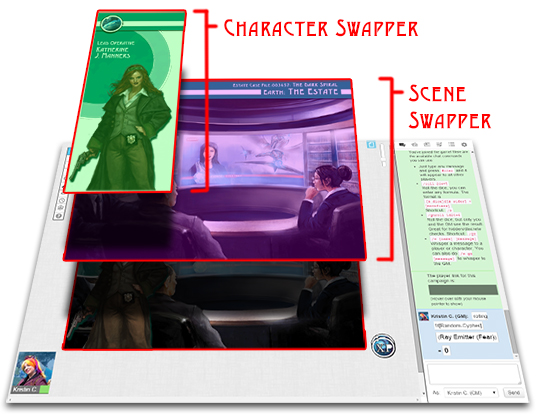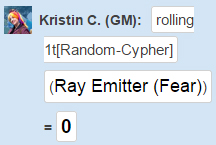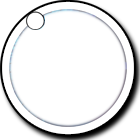Cypher System
From Roll20 Wiki
Page Updated: 2025-04-12 |
| page haven't been updated majorly since 2016, so is likely outdated (Sept. 2020) |
Cypher System is the umpbrella name for the RPG system used in Numenera and The Strange, created by Monte Cook Games(Market). This wiki page will walk through how to setup and play a Roll20 game for any of these systems.
Also check the Cypher system macros & Script:Cypher System Sheet pages.
Character Sheets
If you're creating a game from scratch, you'll want to choose one of the character sheet templates either when you first create the Game OR later on when you're on the Game Settings Page that you can access from the Game's Details Page. These pages are accessed when you're not inside playing your game, but when you're viewing your game list.
- Cypher Systems by Roll20 - A Roll20 Official, all-in-one sheet for Cypher System, Numenera, and The Strange.
- No Thank You, Evil -
- Numenera - Authors:David Hawkins
- The Strange (Multiple Recursion) - has multiple tabs for managing recursion-specific character stuff
Every time you create a new character in the N Journal tab on the Sidebar, the character journal's character sheet is available on the N Journal-tab.
Contents[hide] |
GM Advice
Create A Game
You can create a game for Monte Cook Games on Roll20 from scratch if you wish to. Here are some resources available that can make the process easier.
| Note: Only the GM, the person who is hosting the Roll20 game, needs to buy the module off the Marketplace. |
Inviting Your Friends Or Find Players
Sending Invitations
Each game on Roll20 has its own join link. Once given a Join Link, a player can navigate to that unique url and their user account will be added to the game as a player. If the player has never used Roll20 before, they will be prompted to create a user account before they can load into the game.
The Join Link can be located within the game itself on the Chat Tab of the Sidebar where it says:
- The player link for this game is:
- https://app.roll20.net/join/[unique id #] (← this will need to be highlighted to see)
- (Hover over with your mouse pointer to show)
You can also email invitations directly via the game's Details Page. Incidentally, you can also obtain the unique Join Link of that game from there as well
| Note: Anyone who finds or obtains your Join Link can access your game, so it is best to use discretion when posting or sending it in a public setting. |
Finding Players
If you don't already have a gaming group, this wiki page will help walk you through how to go about finding players for your Monte Cook Game.
Assigning Tokens, Characters and Handouts to Players
| Note: Players can only view and edit their own character sheet if the GM adds the player in the Can Be Edited & Controlled By section. |
Once your players have logged into your game once, their account is added to the game. This makes their username available to attach them to tokens, journal entries and handouts. In Roll20, the players can only see what the GM specifically allows them to. When you're in Edit mode of a Character Journal or Handout there are two important fields to pay attention to: In Player's Journals and Can Be Edited/ & Controlled By
- In Player's Journals: If a player name is added to this field, they will be able to see the entry in their Journal tab and be able to view the information in the Bio & Info section. They will not be able to view, edit or manipulate the Character Sheet tab or the Attributes & Abilities tab.
- Can Be Edited/ & Controlled By: If a player name is added to this field, they will be able to see and edit the entry in their Journal tab. They will be able to view, edit or manipulate the Character Sheet tab and the Attributes & Abilities tab (it is recommended that the Attributes & Abilities tab is left alone as modifying it might cause the character sheet's functionality to break).
Tokens have only one field in edit mode - Controlled By, if a token is linked to a Character Journal, then it will automatically be assigned to whoever is already assigned Edit Permissions to the character.
If Character Journals are linked to a Token, then the GM can click and drag a journal to the tabletop to spawn a copy of that token with the permissions already preset.
Macros & Rolling
Cypher system macros contains lots of advice for the official sheet.
Rolling for Difficulty
When the GM gives a player a difficult rating for a given task, the player rolls directly from her character sheet. In both the Numenera and The Strange character sheets is a section with roll buttons for the Difficulty Scale that are listed sequentially from Simple to Impossible.
If a user has 3D Dice activated in My Settings, a 3D d20 will roll across the Tabletop. Regardless if 3D Dice are used or not, the roll's result will be displayed in the Chat Tab.
Decks
There are monster & other decks available on the marketplace.
How Decks are used.
Experience Points
Since experience points can be traded in as a narrative currency during gameplay, some gaming groups might prefer to use physical objects to represent experience and trade them between one another. This can be simulated in Roll20 with the use of an Infinite Card Deck. The Strange modules available on the Roll20 Marketplace already come with an XP Deck preloaded, but making one from scratch with your own graphics is easy to do too. The GM can show and hide the deck from the tabletop by clicking on Hide/Show button beside the deck in the Decks and Tables tab on the Sidebar.
| Note: You may need to shuffle the card deck before you're able to draw from it. |
When players are given cards, a thumbnail of the back of the card appears above their portrait and if it is set to do so, will also show you the number of how many cards they currently hold. If they wish to give a token to the GM they first click on the thumbnail above their own portrait to open up their hand. Then they grab a token there and drag it to the GM's portrait. This brings up a trade window that the GM can either accept or deny. They can also drag the token to the tabletop and the GM can pick it up it that way too by right clicking on it and selecting Take Card.
The GM can also manage many other features of the card deck like player permission to draw from the deck, see the deck, etc. For a robust list of all Card Deck features check out our wiki page on Card Decks and Rollable Tables.
A Walkthrough to Playing Roll20's The Strange's Marketplace Modules
Here's what you can expect if you decide to run any of the purchasable Monte Cook Games modules on the Roll20 Marketplace.
The Strange and Managing Recursions
Instead of using the same character sheet for all recursions a character could travel to, we recommend that you duplicate the current character journal and then using the copy as the basis for the character in the new recursion. For instance, if you have a journal entry for "Agent Arlo Coulton on Earth". Duplicate it and rename the copy "Agent Arlo Coulton on Ardeyn/Ruk/etc".
To duplicate a character journal you will need to go into Edit Mode by clicking on the Edit Button at the top of the opened journal entry. Below the Tags field in Edit Mode is a Duplicate button. Clicking on it will add a copy to your Journal tab.
Running a Purchased Module
If you've purchased a copy of The Strange Rulebook, The Strange: The Dark Spiral, or the freeThe Strange Starter Pack from the Roll20 Marketplace, they will be listed on the right side of the Game Creation page. This is also where you can access and download the associated PDF rulebooks or adventure pack booklets that come with your purchase.The Marketplace currently has three games that you can purchase for The Strange RPG:
- The Strange: The Curious Case of Tom Mallard includes the full rulebook PDF and the starter module, pre-made as a Roll20 game
- The Strange: The Dark Spiral is the first official adventure game for The Strange. It includes the game PDF as well as the entire adventure set up as a Roll20 game
- The Strange: Starter Pack is a basic kit of graphics, pre-gen character sheets, XP tokens, macros that you can adapt to make your own games with
At default, the Blank Game will be selected. Simply click on the module you would like run to have that checked off instead. This auto selects the character sheet for you too. Create a name for your Game, add Tag keywords if you wish and then click on the I'm Ready, Create Game! button. Your chosen module will load up automatically.
The Play Space
The Strange is a very picturesque game and plays heavily towards setting the right mood. For this reason, the Roll20 Pages in this game have been deliberately designed to prevent you from having to manage dozens of picture handouts. Instead of a single scene kept within a game page, Rollable Tokens have been used to allow you to switch character portraits and backdrops on the fly directly from the Tabletop.
A Rollable Token can have many different images associated to it. You can swap the appearance at will by right clicking on the token, selecting Multi-Sided from the popup menu and then selecting Choose Side. This will bring up a new window with a slider that allows you to cycle through the various images available.
With the exception of dungeon floor maps, all other pages utilize two rollable tokens on the tabletop. The smaller one on the left is the Character Swapper. You can change it to various characters that would be interacting with the PCs at that location. Occasionally it also can be used to reveal some smaller additional guide maps or scenery. The rollable table contents will be noted in your handout notes for each Page. Each Character Swapper has a "blank" side so you can hide the portrait entirely to view the backdrop scene in its entirety.
The larger rollable token that takes up the entirety of the tabletop is the Scene Swapper. This token holds all relevant Show ‘Ems for that location as well as other images that set the mood and setting for the players. Each Scene Swapper token has a side called "Scratch Pad", this blank scene is supplied in the event that you and your players need to take down notes or doodle out a specific location for combat or interaction.
| NOTE: To prevent these tokens from being accidentally moved around during gameplay, the Character and Scene Swapper tokens are sitting on the Background Layer. |
If you ever accidentally delete a token from the tabletop or you wish to add your own graphics, you can replace it by following these steps:
- Go to the Decks and Tables Tab on the Sidebar and find the right rollable table you need
- Click on the Token button, this will place that token on the tabletop
- Right click on the token to bring up its options menu, go to Advanced and toggle off Is Drawing
- Right click again and go to the Advanced section again and select Set Dimensions
- For the Scene Swapper, the dimensions are 1050 pixels wide x 800 pixels high
- For the Portrait Swapper, the dimensions are: 345 pixels wide x 800 pixels high
- Move the tokens into place and use the To Back/Front options in the right click menu to situate them properly on top of each other
- It's easier to place the tokens if you briefly enable the Grid by checking it off in the Page Settings on the Page Toolbar. It is the gear icon next to the desired Page you wish to edit.
- CTRL + M will place the tokens on the map layer if you find yourself working on another layer by mistake.
Features
Pre-Gen PCs
Available in these games are the seven pre-generated characters from The Strange Player's Guide if you would like to use them:
- Paradox
- Agent Dr. Sybil Holloway
- Spinners
- Agent L.G. Babcock III
- Agent Torah "The Windmill" Bishop
- Vectors
- Agent Arlo Coulton
- Agent Vanessa Torgue
Random Cypher Roller
Under the My Settings tab of the Sidebar is a button macro you can use to roll up random cyphers. The cypher table on page 312 of The Strange Rulebook has been transposed over into its own rollable table. The rollable table only includes the cypher name so consult the rulebook if you need a full description of the rolled cypher.Pre-Built XP Chips
Mentioned earlier under Experience Points, each The Strange module comes with the XP Token Infinite Card Deck pre-built and ready to use.
Fog of War & Dynamic Lighting
The Curious Case of Tom Mallard and The Dark Spiral modules both have floor plan maps that utilize the Fog of War tool. This is a special tool that allows the GM to hide areas of the Tabletop from the Players and can reveal or hide parts of it by drawing or erasing Fog from the Tabletop. To learn more, see the wiki page on the Fog of War Tool.
In The Dark Spiral module, the Mouth of Swords Dungeon Map is set up for Dynamic Lighting, which is a special tool available to GMs who are Roll20 Subscribers. This allows areas of the tabletop to hide or reveal themselves automatically as tokens are dragged and moved across the table. If you do not have a subscriber account, you can use the Fog of War tool mentioned earlier to hide and reveal areas manually. To learn more, see the wiki page on Dynamic Lighting.
Jukebox
For The Curious Case of Tom Mallard and The Dark Spiral, an assortment of music tracks have been selected that we feel best set the mood of each location and recursion. You can play the audio by going to the Jukebox tab on the Sidebar. All tracks are by music composer Kevin MacLeod of incompetech.com.
You're welcome to use the tracks provided or include your own. The tracks are sorted by locations and events within the adventure pack and followed by the original track name of MacLeod’s work.
SoundCloud tracks for this module are subject to change.
Kevin MacLeod (incompetech.com)
Licensed under Creative Commons: By Attribution 3.0
http://creativecommons.org/licenses/by/3.0/
Helpful Graphics for The Strange
If you would like to create graphics to complement The Strange: Starter Pack or any one of the other The Strange modules, here are some templates to help you along:
See Also





